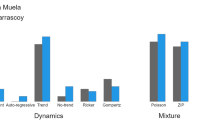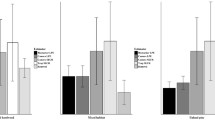Abstract
In community-level ecological studies, generally not all species present in sampled areas are detected. Many authors have proposed the use of estimation methods that allow detection probabilities that are <1 and that are heterogeneous among species. These methods can also be used to estimate community-dynamic parameters such as species local extinction probability and turnover rates (Nichols et al. Ecol Appl 8:1213–1225; Conserv Biol 12:1390–1398). Here, we present an ad hoc approach to estimating community-level vital rates in the presence of joint heterogeneity of detection probabilities and vital rates. The method consists of partitioning the number of species into two groups using the detection frequencies and then estimating vital rates (e.g., local extinction probabilities) for each group. Estimators from each group are combined in a weighted estimator of vital rates that accounts for the effect of heterogeneity. Using data from the North American Breeding Bird Survey, we computed such estimates and tested the hypothesis that detection probabilities and local extinction probabilities were negatively related. Our analyses support the hypothesis that species detection probability covaries negatively with local probability of extinction and turnover rates. A simulation study was conducted to assess the performance of vital parameter estimators as well as other estimators relevant to questions about heterogeneity, such as coefficient of variation of detection probabilities and proportion of species in each group. Both the weighted estimator suggested in this paper and the original unweighted estimator for local extinction probability performed fairly well and provided no basis for preferring one to the other.
Similar content being viewed by others
References
Bailey NTJ (1964) The elements of stochastic processes with applications to the natural sciences. Wiley, New York
Bennetts RE, White GC, Hawksworth FG, Severs SE (1996) The influence of dwarf mistletoe on bird communities in Colorado ponderosa pine forests. Ecol Appl 6:899-909
Boulinier T, Nichols JD, Sauer JR, Hines JE, Pollock KH (1998a) Estimating species richness to make inferences in community ecology: the importance of heterogeneity in species detectability. Ecology 79:1018–1028
Boulinier T, Nichols JD, Hines JE, Sauer JR, Flather CH, Pollock KH (1998b) Higher temporal variability of forest breeding bird communities in fragmented landscapes. Proc Natl Acad Sci U S A 95:7497–7501
Boyce MS (1992) Population viability analysis. Ann Rev Ecol Syst 23:481–506
Bunge J, Fitzpatrick M (1993) Estimating the number of species: a review. J Am State Assoc 88:364–373
Burgman MA, Ferson S, Akçakaya HR (1993) Risk assessment in conservation biology. Chapman Hall, London
Burnham KP, Overton WS (1978) Estimation of the size of a closed population when capture probabilities vary among animals. Biometrika 65:625–633
Burnham KP, Overton WS (1979) Robust estimation of population size when capture probabilities vary among animals. Ecology 60:927–936
Cam E, Nichols JD, Hines JE, Sauer JR (2000) Inferences about nested subset structure when not all species are detected. Oikos 91:428–434
Carothers AD (1973) The effects of unequal catchability on Jolly-Seber estimates. Biometrics 29:79–100
Carothers AD (1979) Quantifying unequal catchability and its effect on survival estimates in an actual population. J Anim Ecol 48:863–869
Chao A, Lee SM, Jeng SL (1992) Estimation of population size for capture—recapture data when capture probabilities vary by time and individual animal. Biometrics 48:201–216
Dawson DK, Sauer JR, Wood PA, Berlanga M, Wilson MH, Robbins CS (1995) Estimating bird species richness from capture and count data. J Appl Stat 22:1063–1068
Derleth EL, McAuley DG, Dwyer TJ (1989) Avian community response to small-scale habitat disturbance in Maine. Can J Zool 67:385–390
Gaston KJ (1994) Rarity. Chapman and Hall, London
Gilpin ME, Soulé ME (1986) Minimum viable populations: processes of species extinctions. In: Soulé ME (ed) Conservation biology: the science of scarcity and diversity. Sinauer, Sunderland, Mass., pp 19–34
Goel NS, Richter-Dyn N (1974) Stochastic models in biology. Academic Press, New York
Hanski I, Kouki J, Halkka A (1993) Three explanations for the positive relationship between distribution and abundance of species. In: Ricklefs RE, Schluter D (eds) Species diversity in ecological communities. University of Chicago Press, Chicago, Ill., pp 108–116
Hines JE, Boulinier T, Nichols JD, Sauer JR, Pollock KH (1999) COMDYN: software to study the dynamics of animal communities using a capture–recapture approach. Bird Study 46:209–217
Karr JR, Robinson SK, Blake JG, Bierregaard RO Jr (1990) Birds of four neotropical forests. In: Gentry AH (ed) Four neotropical rainforests. Yale University Press, New Haven, Conn., pp 237–269
Lee SM, Chao A (1994) Estimating population size via sample coverage for closed capture–recapture models. Biometrics 50:88–97
MacArthur RH, Wilson EO (1967) The theory of island biogeography. Princeton University Press, Princeton, N.J.
McKinney ML (1997) Extinction vulnerability and selectivity: combining ecological and paleontological views. Annu Rev Ecol Syst 28:495–516
Nichols JD, Conroy MJ (1996) Estimation of species richness. In: Wilson DE, Cole FR, Nichols JD, Rudran R, Foster M (eds) Measuring and monitoring biological diversity. Standard methods for mammals. Smithsonian Institute Press, Washington, D.C., pp 226–234
Nichols JD, Boulinier T, Hines JE, Pollock KH, Sauer JR (1998a) Estimating rates of local extinction, colonization and turnover in animal communities. Ecol Appl 8:1213–1225
Nichols JD, Boulinier T, Hines JE, Pollock KH, Sauer JR (1998b) Inference methods for spatial variation in species richness and community composition when not all species are detected. Conserv Biol 12:1390–1398
Norris JL III, Pollock KH (1996) Nonparametric MLE under two closed capture–recapture models with heterogeneity. Biometrics 52:639–649
Patterson BD (1984) Mammalian extinction and biogeography in the southern rocky mountains. In: Nitecki MH (ed) Extinctions. University of Chicago Press, Chicago, Ill., pp 247–293
Patterson BD, Atmar W (1986) Nested subsets and the structure of insular mammalian faunas and archipelagos. Biol J Linn Soc 28:65–82
Pledger S (2000) Unified maximum likelihood estimates for closed capture–recapture models using mixtures. Biometrics 56:434-442
Pollock KH (1982) A capture–recapture sampling design robust to unequal catchability. J Wildl Manage 46:752–757
Robbins CS, Bystrack D, Geissler PH (1986) The breeding bird survey: its first fifteen years, 1965–1979. Resources publication no. 157. US Fish and Wildlife Services, , Washington, D.C.
Sauer JR, Barker RJ, Geissler PH (1994) Statistical aspects of modeling population change from population size data. In: Kendall RJ, Lacher TE Jr (eds) Wildlife toxicology and population modeling. Integrated studies of agroecosystems. CRC, Boca Raton, Fla., pp 451–466
Smith EP, van Belle G (1984) Nonparametric estimation of species richness. Biometrics 40:119–129
Thiollay JM (1995) The role of traditional agroforests in the conservation of rain forest bird diversity in Sumatra. Conserv Biol 9:335–353
Acknowledgements
We are grateful to Dr Emmanuelle Cam and an anonymous referee for their careful reading, useful suggestions and comments that improved our presentation. We also thank Dr Stewart-Oaten for his suggestions on a previous version of this manuscript. This work was funded by a cooperative agreement between North Carolina Cooperative Fish and Wildlife Research Unit at North Carolina State University and USGS Patuxent Wildlife Research Center. The main simulation results were conducted at the Patuxent Wildlife Research Center in Laurel, Maryland while the first author was a research associate in the Statistics Department at North Carolina State University. The first author also acknowledges partial support from the Fundação para a Ciência e a Tecnologia e do FSE (III Quadro Comunitário de Apoio), and the Fundanção Calouste Gulbenkian while on sabbatical leave from the University of Évora, Portugal.
Author information
Authors and Affiliations
Corresponding author
Rights and permissions
About this article
Cite this article
Alpizar-Jara, R., Nichols, J.D., Hines, J.E. et al. The relationship between species detection probability and local extinction probability. Oecologia 141, 652–660 (2004). https://doi.org/10.1007/s00442-004-1641-0
Received:
Accepted:
Published:
Issue Date:
DOI: https://doi.org/10.1007/s00442-004-1641-0




